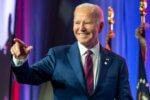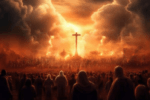Why is the Rastafari religion attracting youth today? Charisma talked to insiders to understand the trend.
Black, white, Asian and Hispanic bob together to the lilting beat as the reggae singer extols harmony, righteousness and justice. It’s hot this afternoon at Miami’s waterside Bicentennial Park, but everyone’s cool.
As far as crowd control goes, the police don’t have much to worry about at the open-air concert that has drawn more than 30,000 music fans for a 12-hour marathon. The dancehall artists–combining reggae and hip-hop–turn the tempo up a bit, but the old-school reggae acts keep everything mellow.
With the welcome-all atmosphere and positive message, it all might almost pass for a gospel concert–but for the pervasive wash of marijuana smoke that hangs over the swaying ranks at the sixth Caribbean Reggae Festival. Fashion also sets this gathering apart from a typical church. There are plenty of ropy dreadlocks among the heads nodding to the music, and hoops of African-power red, black, green and gold on hats, T-shirts and dresses.
Many sport images of late reggae star Bob Marley, the single most influential figure in seeing the spread of Rastafari from a small, island religion to a global movement influencing millions. A good number of those in the crowd, however, do not embrace or even really understand the core beliefs of the faith espoused by the singer of hits such as “One Love” and “Exodus.”
Among the views he promoted through his music–still selling well more than 20 years after his death–are Ethiopian emperor Haile Selassie’s divinity as the black Lion of Judah, mystical oneness with the creator Jah, and the rejection of Western society as ungodly “Babylon.”
But as they sway to the rhythmic reggae offbeat, with its hypnotic groove, many of those in the Miami crowd adopt a marginal version that might be dubbed “Rastafringe”–sort of New Age with attitude. The predominantly college-age throng have the same fuzzy spirituality and vague goodwill championed by their baby boomer elders who turned to healing crystals and karma coaches.
However, though many in the boomer generation cozily wrapped their beliefs into their middle-class lifestyle–twinning their chakras with the country club–their sons and daughters mix their hazy attitude with Rastafari’s keen sense of social injustice, often captured in potent Old Testament imagery.
They are laid-back rebels with a cause–even if they don’t know exactly what it is.
Typical of them are two teenage girls sporting African colors in the Miami crowd who admit they don’t know much about Rastafari but say they are drawn by “the culture, the music, the lifestyle.” A Jewish woman wearing a Marley T-shirt smiles and says the Rasta message is great, she is all for it. Pressed for a definition she shrugs and offers: “Well, peace and harmony.”
The Rastafringe
Such a formless movement may not seem to be particularly significant, but it is that very wooliness that makes it such a major challenge to the church, observers say. This Rastafringe “fits whatever lifestyle you want to live,” comments Jamaican seminary lecturer and apologist Clinton Chisholm, an expert on the movement.
“There’s no pressure on you ethically. It’s an umbrella that doesn’t put any pressure on you–you just love and enjoy your music and do your own thing. … It’s significant in that every person who moves towards Rastafari, even if they are not really deep in conviction or commitment, is a harder person to win to Jesus.”
Even more disturbingly, Bill Spencer, another authority on Rastafari, estimates that 90 percent of those in the Rastafringe come from Christian homes, comfortable with the biblical threads in the movement but rejecting their former churches’ absolutes. At Bicentennial Park their number includes Marcus who, wreathed in marijuana fumes, smiles warmly and tells of rejecting his Pentecostal-Baptist upbringing for “living righteously”–which he defines as doing the right thing by others–as a Rasta.
He also epitomizes another curious trend–the growing influence among middle-class whites of what began with poor, black islanders.
“It strikes a chord with everyone who has ever felt oppressed or marginalized,” comments Spencer of Rastafari. “College is the rebel age, when you are all-fired up, and Rastafari comes with this tremendous counterculture, anti-Establishment. … It gives them a cause.”
When Mark Mohr speaks of Rastafari’s subtle “indoctrination to reject truth without changing your whole inner life,” he does so not only as someone who has studied the scene but also as someone who’s personally experienced the movement.
Raised in a Christian home, he was attracted by the music, the lifestyle, and the widespread championing of marijuana as a sacrament on the grounds that the Bible is supposedly speaking of ganja when it talks of “herb” being given for man’s benefit.
“I thought I had found the perfect religion,” Mohr recalls, “which was a blend of the belief system of my parents with the drug of my choice.”
Some within Rastafari’s small and varied orthodox streams oppose drugs, but for most marijuana is inextricably part of the scene.
If a sniff of the Bicentennial Park air doesn’t underscore that, a glance at some of the concession stands does. Selling alongside the framed portraits of Marley and Selassie–Rasta’s John the Baptist and Jesus, respectively–are king-size Lion of Judah brand roll-your-own cigarette papers, a ganja-user’s staple.
At his stall where music, African-style clothes and accessories are sold, Ras Lee isn’t troubled that many in the crowd don’t really know much about Rastafari, his devotion to which has taken him to Ethiopia several times. He welcomes the nominal devotees, the “weekend dreads.”
“It’s all good,” Lee says, “because eventually they might learn something.”
A Hazy Spirituality
With no central doctrine–even among orthodox Rastas, views about such core issues as the divinity of both Selassie and Jesus vary widely–and no recognizable structure, Rastafari is hard to gauge definitively. But many researchers say that although the Rastafringe numbers in the millions, at the heart there are probably not many more than a million true believers.
There are significant numbers of followers in the United States, Canada and parts of Europe. Last summer Rastas from around the world traveled to Jamaica for the Global Rastafarian Reasoning Summit, an international conference for reflecting on how the movement has grown and changed during the last 70 years.
In addition to revering Selassie, followers claim Ethiopia as the real Zion and commonly follow a radical natural, or Ital, lifestyle that shuns alcohol–but celebrates marijuana, for the most part–and encourages a vegetarian-style diet that rejects processed foods. The striking dreadlocks are their embracing of the Old Testament Nazirite vow to not cut one’s hair as a sign of devotion to God.
Although it has morphed into a sometimes-abstract grouping, Rastafari was born from the black identity movement founded by Jamaican black nationalist Marcus Garvey. He was the father of the Back to Africa movement that championed repatriation, in spirit if not possible in person.
Garvey’s reform efforts turned religious in 1930 when Ras Tafari Makonnen adopted the emperor name Haile Selassie and was crowned Ethiopia’s King of Kings. With his lineage, Rastas claim, tracing back to King David through a union between Solomon and the Queen of Sheba, some saw the new monarch as God incarnate.
Seventy years later, the growing adoption of Rastafringe among young whites is taking away Rastafari’s “real center” as a black religion, argues Chisholm, who is surprised by its continuing influence despite diminishing clarity of belief.
“People really come into it under the influence of the music,” he says, observing “a strong spirit of delusion.” Although Chisholm’s historical research has challenged classic Rasta tenets, he says that “people surrender their belief systems reluctantly.”
“Even though we see contradictory evidence we will hold on to them,” he notes. “It’s enough that I believe it to be true.”
Many like Ras Lee refute the essential challenge to Selassie’s divinity–his 1975 death–by appealing to the Bible. “They can’t prove [he died], can they?” he asks. “Enoch was taken [up and was no more], you know.”
Today as an evangelist using reggae music to reach the Rasta community through his Christian reggae group Christafari, Mohr garnishes one of his songs with portions of an old radio interview in which Selassie urges people to follow the example of Jesus. The Ethiopian leader is widely recognized as having been a devout Christian. He once addressed a Billy Graham evangelism convention and is said to have been horrified when during a visit to Jamaica in 1966 he found himself being deified.
“There’s no way, once you start reading his writings and interviews, that you can look toward the man,” Mohr says. “It’s like worshiping Billy Graham because you identify with what he stands for.”
Although Rastafari watchers comment on the increasing New Age trend in the movement, they also note that some streams are almost evangelical Christian in their beliefs, such as the Twelve Tribes of Israel faction that honors Selassie but points to Jesus as Savior. But most Rastas forsake traditional church settings for informal “reasoning” sessions that can run for hours, often fueled by ganja. Many harbor long-standing suspicions of Westernized Christianity–not surprising, considering the first time Jamaicans were introduced to the name “Jesus” it was that of a visiting slave ship.
Indeed Rastafari was quite strongly anti-white in its early years. Though that stand may have waned over the years, the movement remains fiercely disapproving of homosexuality. Singer Bounty Killer, one of many devout Rastas on the Miami bill, scrapped concerts in England last year after outrage over some of his anti-gay lyrics.
Planting Seeds
For the most part, though, with their wild-looking dreads and Old Testament prophetlike attitudes, Rastas can present an image far more fear-inducing in outsiders than their typically peaceful natures warrant. Together with a somewhat loose way of referencing the Bible, it all means they are not easily reached with the gospel.
Standing well over 6 feet and with flowing dreads, Ras Junior often finds that people are intimidated by his appearance, until they discover his warm personality. He further confuses the already fuzzy spirituality by declaring that “Rastafari is God but in a different way for me, because I know Jesus Christ is our ultimate Savior.”
He describes Rastafari as “uplifting … knowledge … the way of life” and says that Selassie “opened my eyes to make me find Jesus.”
Last year he took part in a special encounter intended to build bridges between evangelical Christians in Boston and members of the local Rastafari community. The Kingdom Rise, Kingdom Fall conference at Harvard Divinity School featured music, art and workshops examining Christianity and Rastafari.
Among the speakers was Gordon-Conwell Theological Seminary adjunct associate professor Spencer–author and editor of two highly regarded books on Rastafari (Dread Jesus and Chanting Down Babylon: The Rastafari Reader) and a frequent visitor to the islands–who has a deep appreciation for reggae and for Rastafari’s concerns with injustice and oppression.
Despite the movement’s increasing acceptance of and by young whites, Spencer still sees Rastafari at its core more as a black identity movement than a religion, per se. “You can accept Selassie as God incarnate, the return of Jesus or just a human being and you will be perfectly accepted as Rasta,” he points out.
He thinks that talking of conversion in terms of leaving Rastafari for the typical evangelical church is not necessarily helpful. “If Rastas become better Rastas, they will follow Haile Selassie, and they will worship his Lord–Jesus,” he says.
Ethiopian evangelist Daniel Haile finds his nationality is a drawing card for Rastas as he travels and ministers around the world. His converts include someone closely associated with the Marley family–whose late patriarch himself is said by some to have made a personal commitment to Christ before his death from cancer in 1981.
Haile plans to hold a crusade in Jamaica to capitalize on the connection Rastas feel with his homeland, the first country mentioned in the Bible and referenced more than 50 times. He sees in Rastafari “some kind of deceptive spirit … through the music and the marijuana and the lifestyle.”
Mohr agrees that many attracted by those hooks “are drawn into something they are not really aware of.”
“It kind of creeps in. What has become their church is the concerts, and the evangelists are the artists,” he explains.
With that and his own experience in mind, Mohr urges parents to be “concerned about and aware when their son or daughter is listening to this kind of music” because he believes that “as far as Satan can get the focus off Christ he has won.”
“It starts to get them to challenge the Bible,” he says.
Marley continues to be Rastafari’s chief evangelist. Thousands gather each year at reggae festivals to celebrate his life and message. But a whole new generation of dancehall and traditional or roots reggae artists are ardent Rastas, too. Buju Banton. Sizzla. Elephant Man. Beenie Man. Capleton.
Rodney Peterson, executive director of Boston Theological Institute, which helped host the Kingdom Rise, Kingdom Fall gathering, thinks what Rastafari represents culturally and spiritually is more significant than what it actually professes, which is “how an alienated group of people have been attracted to and repelled by the gospel of Jesus.”
That challenge to the church is personified by Nesta Black, who found his way to Rastafari as a white teenager, jamming with reggae musicians.
“[They] acted more in accordance with true Christianity than many of the chapter-and-verse quoting Bible thumpers who made me feel doomed in the Pentecostal and Catholic churches I attended,” he says.
Today, holding down a corporate job, Black says he “wouldn’t look out of place at a Republican fund-raiser” but adds that his appearance isn’t his true identity.
“I look like Babylon, but I am not of Babylon,” he says. “I have always found the true Rasta a person of great faith, kindness and compassion … the true meaning of ‘One Love.'”
It’s a Reggae Revival
Top musical artists from Rastafari’s island of Jamaica are leading the way to Christ.
While reggae music continues to spread Rastafari’s message of Jah love around the world, a revival of sorts is occurring among artists in the style’s island birthplace who are finding true peace in Jesus’ love.
“So many musicians and singers have converted to Christianity, it’s amazing. The number is growing daily,” says Judy Mowatt, revered as a member of Bob Marley’s
I-Threes backing group and a leading reggae artist in her own right.
“He is drawing them. I know God is changing the singers and the players because they can influence the rest of society.”
A longtime follower of Rastafari, Mowatt came to Christ a few years ago when a family crisis made her realize she didn’t have peace.
“I knew there had to be something more, something was missing from my life,” she remembers. “I had tried everything and nothing could satisfy me or fulfill me–not shopping or men or external things.
“My life was filled with things and I was still empty. Only when Jesus Christ came in and filled that void did I realize that He was what I needed.”
Now a praise and worship leader at her local “Spirit-filled” church, she still continues to tour occasionally. Although her music was always “God focused,” she adds that “what I was giving them was not of Christ–it will have to be done over.”
Rastafari researcher Bill Spencer observes that many of those who have become Christians have been drawn by charismatic churches, with whom they share a belief “that God is active and concerned about people.”
Tommy Cowans–Marley’s former tour manager and longtime emcee of the renowned Reggae Sunsplash tours–and his singer wife, Carlene Davis, have collaborated on several gospel albums since her conversion in 1996.
Also going back to the concert halls with a different message is Papa San, whose dancehall music–a blend of traditional reggae and hip-hop–took him to the top of the secular charts in the 1990s.
The son of “an old-time Rasta man,” San began studying the faith for himself but could not accept the idea that Ethiopian emperor Haile Selassie was God. Since his conversion to Christ in 1997 he has burned all his secular music awards and dedicated himself to evangelism through music.
“I’m a fisher of men and music is my bait,” he says, acknowledging reggae’s power in spreading the Rasta message. “Music is created in heaven, not on Earth. When all this [world] is done music will still remain because there will be worship in heaven.
Papa San adds: “What people don’t understand is that music is the No. 1 vehicle for carrying messages. Rastas don’t have a church, but they have lots of music ‘evangelists’–they listen to people like Bob Marley.” *
Andy Butcher is senior writer for Charisma and editor of Christian Retailing magazine. He attended a reggae music festival in Miami to compile this report.






Leave a Comment
You must be logged in to post a comment.